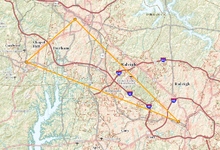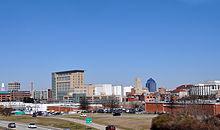
A | B | C | D | E | F | G | H | CH | I | J | K | L | M | N | O | P | Q | R | S | T | U | V | W | X | Y | Z | 0 | 1 | 2 | 3 | 4 | 5 | 6 | 7 | 8 | 9
Research Triangle | |
|---|---|
Representations of the Research Triangle (from top to bottom): skyline of Raleigh, skyline of Durham, and the Old Well in Chapel Hill | |
 | |
| Country | |
| State | |
| Largest city | Raleigh |
| Other cities | Durham Chapel Hill Cary |
| Area | |
| • Total | 4,766 sq mi (12,340 km2) |
| Population (2020) | |
| • Density | 442/sq mi (171/km2) |
| • CSA | 2,106,463 (32nd) |
| GDP | |
| • Raleigh–Durham–Cary (CSA) | $183.624 billion (2022) |
| • Raleigh (MSA) | $119.675 billion (2022) |
| • Durham-Chapel Hill (MSA) | $63.950 billion (2022) |
| Time zone | UTC−5 (EST) |
| • Summer (DST) | UTC−4 (EDT) |
| Area code(s) | 919, 984 |
The Research Triangle, or simply The Triangle, are both common nicknames for a metropolitan area in the Piedmont region of the U.S. state of North Carolina. Anchored by the cities of Raleigh and Durham and the town of Chapel Hill, the region is home to three major research universities: North Carolina State University, Duke University, and the University of North Carolina at Chapel Hill, respectively. The "Triangle" name originated in the 1950s with the creation of Research Triangle Park located between the three anchor cities, which is the largest research park in the United States and home to numerous high tech companies.[4]
The nine-county region, officially named the Raleigh-Durham-Cary, NC Combined Statistical Area by the Office of Management and Budget, comprises the Raleigh-Cary, Durham-Chapel Hill, and Henderson, NC Metropolitan Statistical Areas. The 2020 census put the population of the area at 2,106,463, making it the second-largest combined statistical area in North Carolina, behind Charlotte.[5] The Raleigh–Durham television market includes a broader 24-county area which includes Fayetteville, North Carolina, and has a population of 2,726,000 persons.[6] Most of the Triangle is part of North Carolina's first, second, fourth, ninth, and thirteenth congressional districts.[7]
The region is sometimes confused with the Piedmont Triad, which is a North Carolina region adjacent to and directly west of the Triangle comprising Greensboro, Winston-Salem, and High Point, among other cities.
Definitions

Depending on which definition of the Research Triangle region is used, as few as three or as many as 16 counties are included as part of the region. The three core counties of Wake, Durham, and Orange are the homes of the three research universities for which the area is named.
Combined Statistical Area
As of September 14, 2018, the US Office of Management and Budget (OMB) delineated the Raleigh-Durham-Cary Combined Statistical Area as consisting of two metropolitan and one micropolitan statistical areas.[8] Those three statistical areas in turn are defined as consisting of a total of nine counties. The MSAs and their constituent counties are:
- Durham-Chapel Hill MSA
- Chatham County
- Durham County
- Granville County
- Orange County
- Person County
- Henderson μSA
- Vance County
- Raleigh-Cary MSA
- Franklin County
- Johnston County
- Wake County
Prior to September 2018, the OMB had used the name Raleigh-Durham-Chapel Hill Combined Statistical Area and it included several additional counties.[9] The Dunn Micropolitan Statistical Area (Harnett County) and Sanford Micropolitan Statistical Area (Lee County) were moved to the Fayetteville-Sanford-Lumberton Combined Statistical Area, while the Oxford Micropolitan Statistical Area (Granville County) was folded into the Durham-Chapel Hill Metropolitan Statistical Area. The Raleigh Metropolitan Statistical Area was also renamed the Raleigh-Cary Metropolitan Statistical Area.
The table below outlines the populations of the constituent counties of the Raleigh–Durham-Cary Combined Statistical Area as of the 2020 Census.[10]
| Census | Pop. | Note | %± |
|---|---|---|---|
| 1950 | 483,418 | — | |
| 1960 | 534,029 | 10.5% | |
| 1970 | 628,319 | 17.7% | |
| 1980 | 765,191 | 21.8% | |
| 1990 | 962,962 | 25.8% | |
| 2000 | 1,315,016 | 36.6% | |
| 2010 | 1,740,185 | 32.3% | |
| 2020 | 2,106,463 | 21.0% | |
| 2020[11] | |||
| County | 2023 Estimate | 2020 Census | Change |
|---|---|---|---|
| Wake County | 1,190,275 | 1,129,410 | +5.39% |
| Durham County | 336,892 | 324,833 | +3.71% |
| Johnston County | 241,955 | 215,999 | +12.02% |
| Orange County | 150,626 | 148,696 | +1.30% |
| Chatham County | 81,624 | 76,285 | +7.00% |
| Franklin County | 77,001 | 68,573 | +12.29% |
| Granville County | 62,192 | 60,992 | +1.97% |
| Vance County | 42,301 | 42,578 | −0.65% |
| Person County | 39,737 | 39,097 | +1.64% |
| Total | 2,222,603 | 2,106,463 | +5.51% |
Regional partnerships
The members of the Research Triangle Regional Partnership are:[12]
All counties in North Carolina are in one of 16 regional councils which provide programs and services to local governments. The Triangle J Council of Governments includes Chatham, Durham, Johnston, Lee, Moore, Orange, and Wake Counties.[13] The northern Triangle counties of Person, Granville, Franklin, Vance, and Warren are part of the Kerr-Tar Regional Council of Governments.
Cities


The Triangle region, as defined for statistical purposes as the Raleigh–Durham–Cary CSA, comprises nine counties, although the U.S. Census Bureau divided the region into two metropolitan statistical areas and one micropolitan area in 2003. The Raleigh-Cary metropolitan area comprises Wake, Franklin, and Johnston Counties; the Durham-Chapel Hill metropolitan area comprises Durham, Orange, Chatham, Granville, and Person Counties; and the Henderson micropolitan area comprises Vance County.
Some area television stations define the region as Raleigh–Durham–Fayetteville. Fayetteville is more than 50 miles (80 km) from Raleigh, but is part of the Triangle television market.



